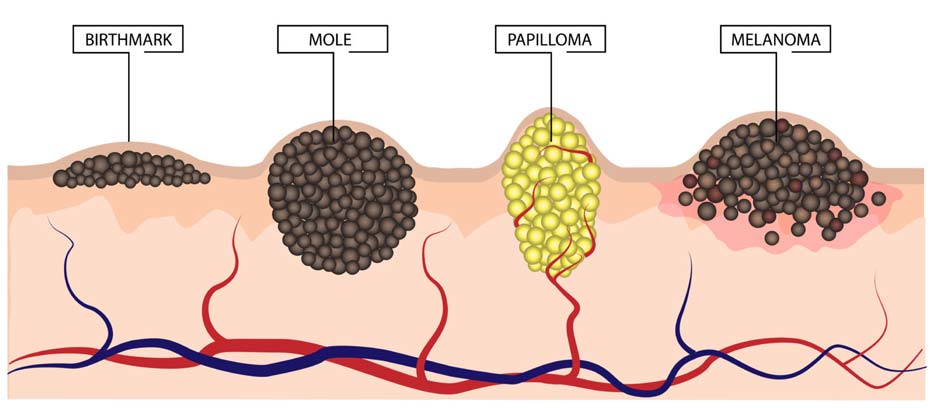Moles or Melanoma?
Nearly everyone has at least one mole — the medical term is “nevus” — a flat or raised colored spot on the skin. These spots (“nevi”) are created when skin pigment cells called melanocytes assemble into clusters. A mole can appear anywhere on your body, and new moles can appear into your 40s. Most moles are harmless and don’t change, but others may grow, change shape, or change color. Some may turn cancerous.
 The first sign of melanoma in a mole is often a change in the size, shape, or color of an existing mole, or the appearance of a new mole. Since the vast majority of cutaneous melanomas are visible on the skin, there is a good chance of detecting the disease in its early stages before it has had a chance to grow and spread—if you know what to look for.
The first sign of melanoma in a mole is often a change in the size, shape, or color of an existing mole, or the appearance of a new mole. Since the vast majority of cutaneous melanomas are visible on the skin, there is a good chance of detecting the disease in its early stages before it has had a chance to grow and spread—if you know what to look for.
Early detection is important because when melanoma is found and treated early, the chances for long-term survival are excellent. As melanoma progresses, it becomes increasingly harder to treat and has a worse outcome.
While all moles have the potential to develop into melanoma, the risk is very low for most. But certain moles are more specifically associated with melanoma, so learning about these moles is critical.
Moles may be congenital or acquired. Congenital nevi are present at birth. Acquired nevi appear during childhood or adulthood. Those people with congenital nevi have an increased risk of developing melanoma.
Moles may be ordinary or atypical (also called dysplastic). Atypical moles are larger than a pencil eraser and shaped irregularly. They are usually uneven in color, with a dark brown center. The borders of atypical moles may be irregular, with a lighter or reddish color, and unevenness or black dots around the edge. Atypical moles tend to run in families. Those people with five or more atypical moles are at increased risk of developing melanoma. Even people with just one unusually shaped or very large mole have an increased risk of melanoma. The risk increases with the number of dysplastic nevi. Those people with 50 or more normal moles have a higher risk of developing melanoma.
Any mole has the potential to develop into melanoma and should be routinely checked for changes. Those people who have congenital nevi and/or atypical nevi should have heightened awareness because these moles are specifically associated with an increased risk of developing melanoma.
Learn more about different types of moles and lesions here.
Mole Facts
Definition: The term “nevus” means a collection of the same kind of cell. A melanocytic nevus, as the name suggests, means a collection of melanocytes. Because melanocytic nevi are by far the most common nevi seen or examined, doctors will often drop the word “melanocytic” and just refer to them as “nevus.” The word “nevus” is the Latin word for “birthmark.”
Shape: Moles may be flat or raised, round or oval, and most are smaller than 6 millimeters, or 1/4 inch, in diameter, like the width of a pencil eraser. The borders are usually smooth and have a defined outline.
Color: Moles can be pink flesh tones to dark brown or black. Ordinary moles are usually a uniform brown, tan, or flesh-colored spots.
Number: The number of moles one has is determined by genes and the amount of sun exposure.

Changes in Moles
- If you notice changes in a mole or a new mole, contact your dermatologist for a skin evaluation.
- Usually moles don’t change in size, shape, or color from year to year.
Many melanomas arise in “normal” skin, where there was no previous mole. - Moles may emerge anywhere on the skin, either singly or in groups.
- Several moles may appear on the skin at the same time, especially in areas that have been exposed to the sun.
- Moles may darken following sun exposure or during pregnancy.
- During adulthood, moles often lose their pigmentation, and they may even seem to disappear in old age.
- Remember, these normal changes occur VERY slowly, while changes in moles that make one concerned about possible melanoma occur quickly, in the order of weeks to months.
- If you ever have a question about a change in a mole, do not brush it off. See a physician to evaluate it.
When Should I See My Healthcare Provider?
If you notice any mole, spot, or bump that has any feature described in the ABCDE melanoma rule, you should see your healthcare provider as soon as possible.
